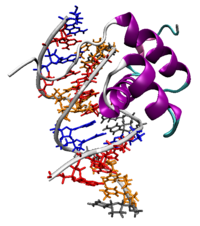
Photo from wikipedia
Precise tuning of gene expression, accomplished by regulatory networks of transcription factors, epigenetic modifiers, and microRNAs, is crucial for the proper neural development and function of the brain cells. The… Click to show full abstract
Precise tuning of gene expression, accomplished by regulatory networks of transcription factors, epigenetic modifiers, and microRNAs, is crucial for the proper neural development and function of the brain cells. The SOX transcription factors are involved in regulating diverse cellular processes during embryonic and adult neurogenesis, such as maintaining the cell stemness, cell proliferation, cell fate decisions, and terminal differentiation into neurons and glial cells. MicroRNAs represent a class of small non-coding RNAs that play important roles in the regulation of gene expression. Together with other gene regulatory factors, microRNAs regulate different processes during neurogenesis and orchestrate the spatial and temporal expression important for neurodevelopment. The emerging data point to a complex regulatory network between SOX transcription factors and microRNAs that govern distinct cellular activities in the developing and adult brain. Deregulated SOX/microRNA interplay in signaling pathways that influence the homeostasis and plasticity in the brain has been revealed in various brain pathologies, including neurodegenerative disorders, traumatic brain injury, and cancer. Therapeutic strategies that target SOX/microRNA interplay have emerged in recent years as a promising tool to target neural tissue regeneration and enhance neurorestoration. Numerous studies have confirmed complex interactions between microRNAs and SOX-specific mRNAs regulating key features of glioblastoma. Keeping in mind the crucial roles of SOX genes and microRNAs in neural development, we focus this review on SOX/microRNAs interplay in the brain during development and adulthood in physiological and pathological conditions. Special focus was made on their interplay in brain pathologies to summarize current knowledge and highlight potential future development of molecular therapies.
Journal Title: Neural Regeneration Research
Year Published: 2022
Link to full text (if available)
Share on Social Media: Sign Up to like & get
recommendations!